The Flame Photometer Market is estimated to be valued at USD 2.2 billion in 2025 and is projected to reach USD 6.1 billion by 2035, registering a compound annual growth rate (CAGR) of 10.8% over the forecast period.
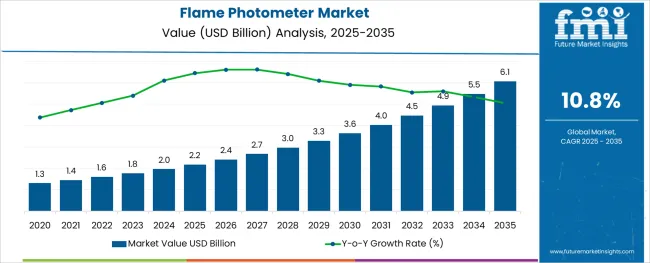
The flame photometer market is growing steadily due to the increasing need for precise elemental analysis in various industrial applications. Industries such as automotive rely heavily on accurate chemical composition testing for quality control and material verification. Technological improvements in photometer design have enhanced sensitivity, accuracy, and ease of use, making these instruments more appealing for routine laboratory and field testing.
Expanding industrial production and stricter regulatory requirements for emissions and material composition are further driving adoption. Additionally, the growing emphasis on environmental monitoring and safety standards in automotive and related sectors has increased the demand for reliable flame photometry.
Future market growth is expected to be fueled by the continuous development of portable and automated photometers, enabling faster and more efficient testing. The Industrial Flame Photometer product type and the automotive end-use segment are projected to lead the market.
The market is segmented by Product Type and End Use and region. By Product Type, the market is divided into Industrial Flame Photometer, Laboratory Refractometer, Research Flame Photometer, and Accessories. In terms of End Use, the market is classified into Automotive, Aerospace, Petrochemical, Biomedical, Food & Beverages, Water & Waste Water Management, and Others. Regionally, the market is classified into North America, Latin America, Western Europe, Eastern Europe, Balkan & Baltic Countries, Russia & Belarus, Central Asia, East Asia, South Asia & Pacific, and the Middle East & Africa.
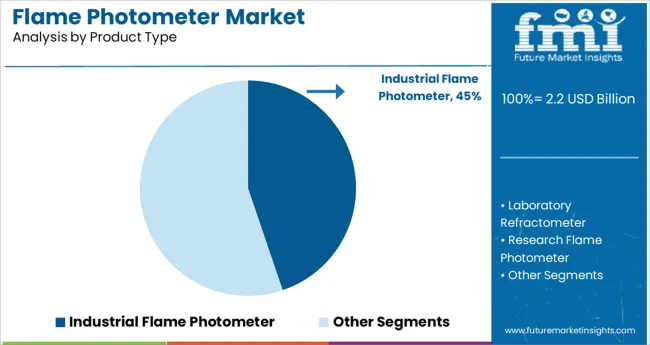
The Industrial Flame Photometer segment is expected to hold 44.8% of the flame photometer market revenue in 2025, reflecting its primary role in industrial chemical analysis. This segment benefits from robust demand in applications requiring fast and accurate quantification of metal ions in complex mixtures. Industrial users value the durability and reliability of these photometers for routine testing environments.
The ability to handle large sample volumes and provide reproducible results has made industrial flame photometers a preferred choice across manufacturing and quality assurance labs. As industries increasingly adopt stringent quality controls and regulatory standards, the need for dependable industrial-grade photometers is anticipated to grow steadily.
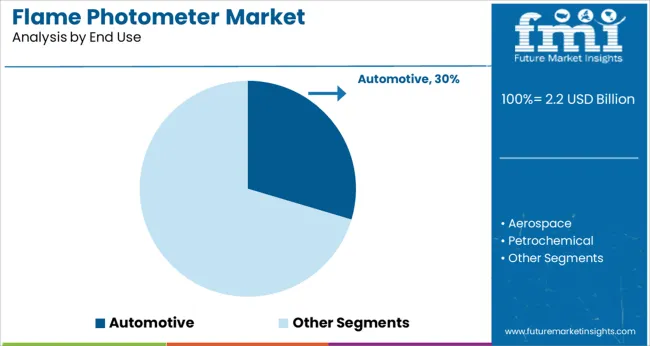
The automotive segment is projected to represent 29.6% of the flame photometer market revenue in 2025, maintaining its position as a significant end-use sector. The automotive industry requires precise elemental analysis for fuel testing, lubrication monitoring, and material verification to ensure vehicle performance and regulatory compliance.
Flame photometers provide critical data for controlling the quality of fluids and materials used in automotive manufacturing and maintenance. Increased focus on reducing emissions and enhancing engine efficiency has further expanded the use of these instruments.
With ongoing advancements in automotive technologies and environmental standards, the automotive end-use segment is expected to sustain strong demand for flame photometry solutions.
Flame photometer is increasingly used for detecting and verifying the concentration of earth alkaline components and alkaline in petrochemical and biomedical industries. This is expected to boost the sales in the market.
Besides this, expansion of water & waste water management industry in Asia Pacific countries such as India and China will push the adoption of flame photometer. Integration of intelligent security mechanism and need for high measurement equipment in diverse industries will push the sales over the projection period.
High initiation cost of flame photometers is one of the major factors restraining the growth in the market. Also, international strict regulations and standards set by government is encouraging manufacturers to develop advanced flame photometers.
However, emerging players in low-and middle-income countries are facing challenge due to the stringent regulations. This is likely to limit the sales of flame photometers in emerging economies.
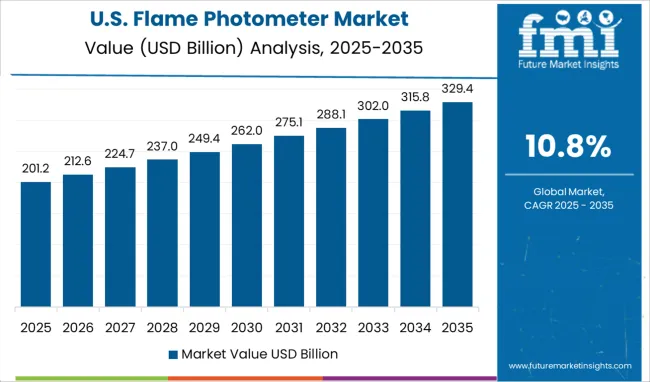
According to Future Market Insights, North America is expected to dominate the global flame photometer market. With rapid industrialization and expansion of biomedical industry in the U.S., the market is expected to witness impressive growth over the forecast period.
As per the study, the increase in research and development activities in the development advanced laboratory flame photometer will boost the demand in North America. Further, application of industrial flame photometer in aerospace industry will drive the sales in the U.S.
As per the study, Asia Pacific is expected to be the second-largest flame photometer market. Sales of flame photometer in Asia Pacific are expected to contribute over 13.7% of overall demand share in 2025.
Growing application of laboratory and industrial flame photometer in biomedical, pharmaceutical, and aerospace industries will fuel the growth in the region. Besides this, favorable government policies to promote the growth in industrial sector will boost the adoption in India and China.
As these photometers are cost-effective and advent of advanced flame photometers in India and China will propel the growth in Asia Pacific flame photometer market. According to FMI, Europe is expected to retain the dominance, accounting for around 11% of demand share in the market.
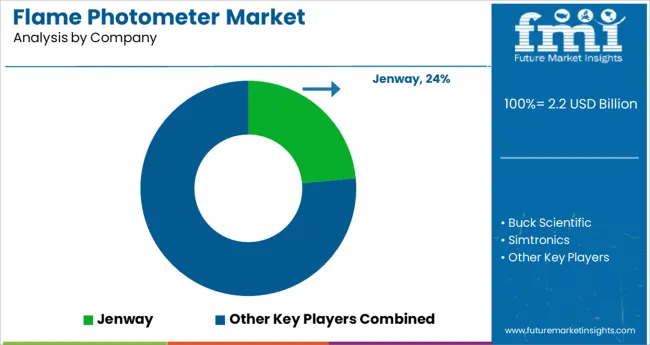
Some of the key participants present in the global flame photometer market include Simtronics Advanced Technical Services, Agilent, Bibby Scientific, Burkard Scientific, and BWB Technologie samong others.
Key players in the global flame photometer market are introducing new product launches to increase their revenues. Some of the players are forming alliances with leading end users to strengthen their presence in the industry.
Meanwhile, some of the other players are adopting inorganic growth strategies such as mergers and acquisition to expand their customer base.
| Report Attribute | Details |
|---|---|
| Base Year for Estimation | 2024 |
| Historical Data | 2020 to 2024 |
| Forecast Period | 2025 to 2035 |
| Quantitative Units | Revenue in billion and CAGR from 2025 to 2035 |
| Report Coverage | Revenue Forecast, Volume Forecast, Company Ranking, Competitive Landscape, Growth Factors, Trends and Pricing Analysis |
| Segments Covered | Product Type, End Use, Region |
| Regions Covered | North America; Latin America; Western Europe; Eastern Europe; APEJ; Japan; Middle East and Africa |
| Key Countries Profiled | USA, Canada, Brazil, Argentina, Germany, UK, France, Spain, Italy, Nordics, BENELUX, Australia & New Zealand, China, India, ASEAN, GCC, South Africa |
| Key Companies Profiled | Jenway; Buck Scientific; Simtronics; Agilent; Bibby Scientific; GDV; Kruss; Burkard Scientific; Spectrolab Systems; Advanced Technical Services; BWB Technologies; Others |
| Customization | Available Upon Request |
The global flame photometer market is estimated to be valued at USD 2.2 billion in 2025.
It is projected to reach USD 6.1 billion by 2035.
The market is expected to grow at a 10.8% CAGR between 2025 and 2035.
The key product types are industrial flame photometer, laboratory refractometer, research flame photometer and accessories.
automotive segment is expected to dominate with a 29.6% industry share in 2025.






Full Research Suite comprises of:
Market outlook & trends analysis
Interviews & case studies
Strategic recommendations
Vendor profiles & capabilities analysis
5-year forecasts
8 regions and 60+ country-level data splits
Market segment data splits
12 months of continuous data updates
DELIVERED AS:
PDF EXCEL ONLINE
Flame Detector Market Size and Share Forecast Outlook 2025 to 2035
Flameproof Equipment Market Size and Share Forecast Outlook 2025 to 2035
Flame Barrier Market Size and Share Forecast Outlook 2025 to 2035
Flame Resistant Fabrics Market Size and Share Forecast Outlook 2025 to 2035
Flame Retardant Masterbatch Market Size and Share Forecast Outlook 2025 to 2035
Flame Ionization Detectors Market Size and Share Forecast Outlook 2025 to 2035
Flame Proof Lighting Market Growth 2025 to 2035
Flame Retardant Chemicals Market Growth - Trends & Forecast 2025 to 2035
Flame Retardant Film Market Analysis & Forecast 2024-2034
Flame Retardant Market Growth – Trends & Forecast 2024-2034
Flame Arrester Market
Aramid Flame Retardant Webbing Market Size and Share Forecast Outlook 2025 to 2035
Bromine Flame Retardant Market Growth – Trends & Forecast 2024-2034
Inorganic Flame Retardants Market
North America Flame Retardant Thermoplastics Market Size and Share Forecast Outlook 2025 to 2035
Non-Halogenated Flame Retardants Market- Growth & Demand 2025 to 2035
Reactive Brominated Flame Retardants Market Size and Share Forecast Outlook 2025 to 2035
Polymeric Brominated Flame Retardants Market Size and Share Forecast Outlook 2025 to 2035
Small Molecule Brominated Flame Retardants Market Size and Share Forecast Outlook 2025 to 2035
Spectrophotometers Market Size and Share Forecast Outlook 2025 to 2035

Thank you!
You will receive an email from our Business Development Manager. Please be sure to check your SPAM/JUNK folder too.
Chat With
MaRIA